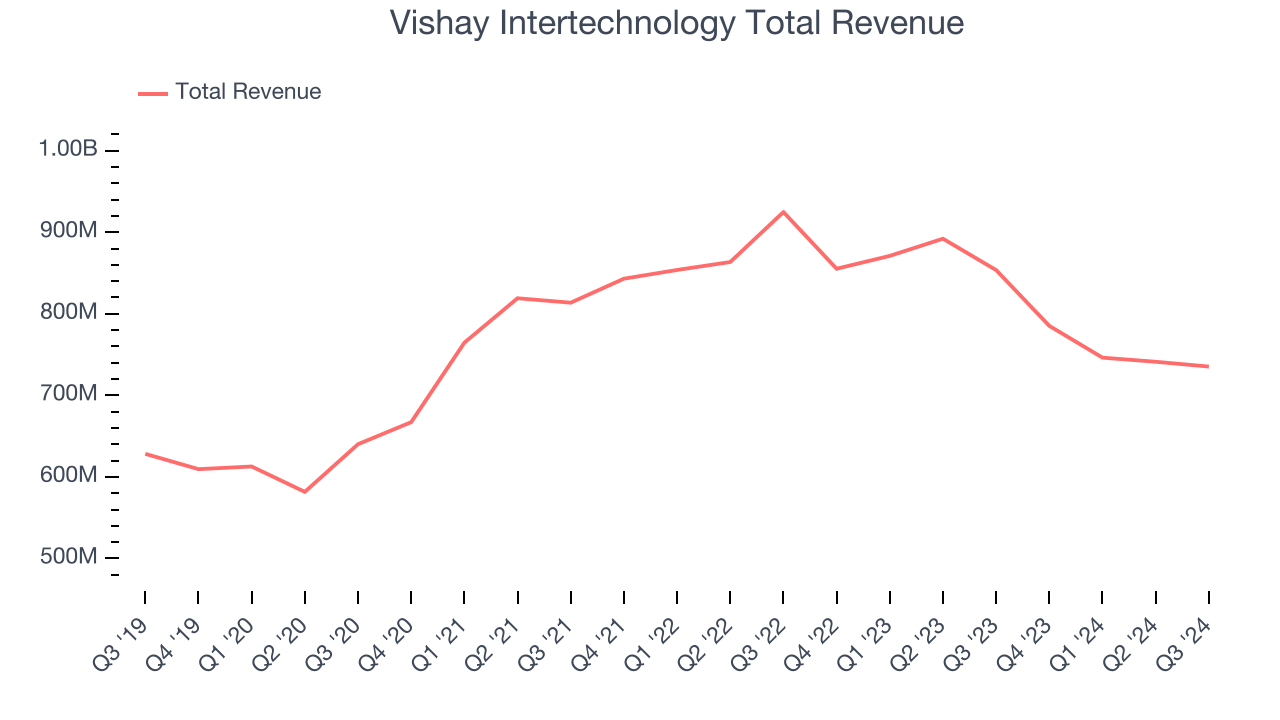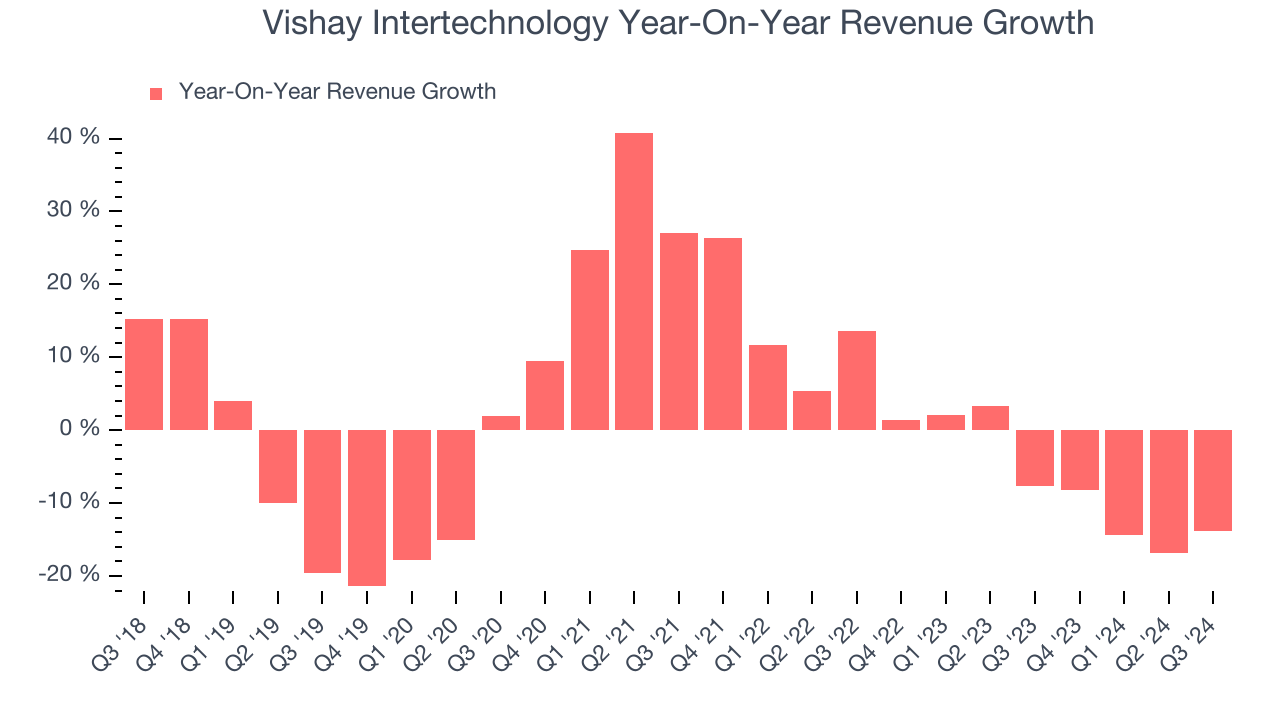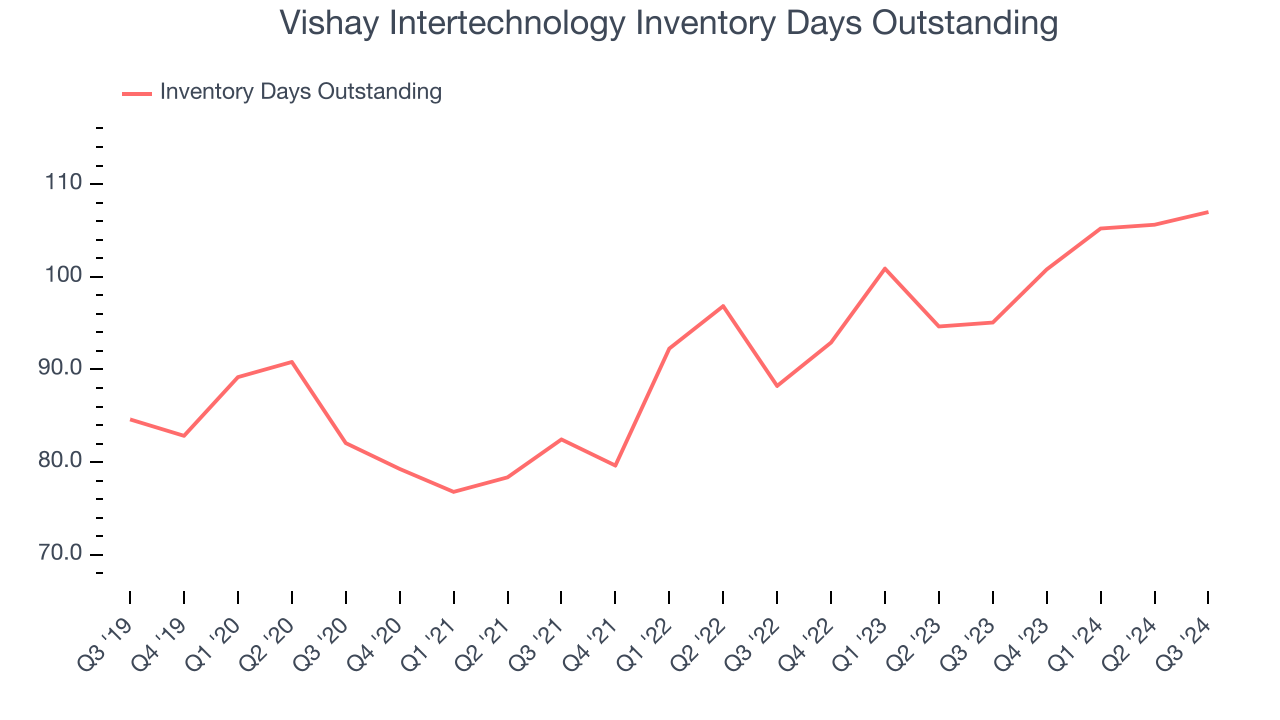Semiconductor manufacturer Vishay Intertechnology (NYSE:VSH) fell short of the market’s revenue expectations in Q3 CY2024, with sales falling 13.9% year on year to $735.4 million. The company’s full-year revenue guidance of $720 million at the midpoint came in 75.9% below analysts’ estimates. Its GAAP loss of $0.14 per share was also 197% below analysts’ consensus estimates.
Is now the time to buy Vishay Intertechnology? Find out by accessing our full research report, it’s free.
Vishay Intertechnology (VSH) Q3 CY2024 Highlights:
- Revenue: $735.4 million vs analyst estimates of $748.8 million (1.8% miss)
- EPS: -$0.14 vs analyst estimates of $0.15 (-$0.29 miss)
- EBITDA: $71.51 million vs analyst estimates of $83.08 million (13.9% miss)
- Gross Margin (GAAP): 20.5%, down from 27.8% in the same quarter last year
- Inventory Days Outstanding: 107, up from 106 in the previous quarter
- Operating Margin: -2.5%, down from 13.5% in the same quarter last year
- EBITDA Margin: 9.7%, down from 18.9% in the same quarter last year
- Free Cash Flow was -$8.83 million, down from $55.5 million in the same quarter last year
- Market Capitalization: $2.33 billion
“For the third consecutive quarter this year, revenue has held fairly constant, reflecting a prolonged period of inventory de-stocking as the pace of consumption by industrial customers remains slow, backlogs are pushed out and macroeconomic conditions in Europe worsen,” said Joel Smejkal, President and CEO.
Company Overview
Named after the founder's ancestral village in present-day Lithuania, Vishay Intertechnology (NYSE:VSH) manufactures simple chips and electronic components that are building blocks of virtually all types of electronic devices.
Analog Semiconductors
Demand for analog chips is generally linked to the overall level of economic growth, as analog chips serve as the building blocks of most electronic goods and equipment. Unlike digital chip designers, analog chip makers tend to produce the majority of their own chips, as analog chip production does not require expensive leading edge nodes. Less dependent on major secular growth drivers, analog product cycles are much longer, often 5-7 years.
Sales Growth
Reviewing a company’s long-term performance can reveal insights into its business quality. Any business can have short-term success, but a top-tier one sustains growth for years. Regrettably, Vishay Intertechnology’s sales grew at a weak 1.2% compounded annual growth rate over the last five years. This shows it failed to expand in any major way, a rough starting point for our analysis. Semiconductors are a cyclical industry, and long-term investors should be prepared for periods of high growth followed by periods of revenue contractions.

We at StockStory place the most emphasis on long-term growth, but within semiconductors, a half-decade historical view may miss new demand cycles or industry trends like AI. Vishay Intertechnology’s history shows it grew in the past but relinquished its gains over the last two years, as its revenue fell by 7.1% annually. 
This quarter, Vishay Intertechnology missed Wall Street’s estimates and reported a rather uninspiring 13.9% year-on-year revenue decline, generating $735.4 million of revenue.
Looking ahead, sell-side analysts expect revenue to grow 6.8% over the next 12 months, an improvement versus the last two years. While this projection illustrates the market believes its newer products and services will spur better performance, it is still below average for the sector.
Here at StockStory, we certainly understand the potential of thematic investing. Diverse winners from Microsoft (MSFT) to Alphabet (GOOG), Coca-Cola (KO) to Monster Beverage (MNST) could all have been identified as promising growth stories with a megatrend driving the growth. So, in that spirit, we’ve identified a relatively under-the-radar profitable growth stock benefitting from the rise of AI, available to you FREE via this link.
Product Demand & Outstanding Inventory
Days Inventory Outstanding (DIO) is an important metric for chipmakers, as it reflects a business’ capital intensity and the cyclical nature of semiconductor supply and demand. In a tight supply environment, inventories tend to be stable, allowing chipmakers to exert pricing power. Steadily increasing DIO can be a warning sign that demand is weak, and if inventories continue to rise, the company may have to downsize production.

This quarter, Vishay Intertechnology’s DIO came in at 107, which is 16 days above its five-year average, suggesting that the company’s inventory has grown to higher levels than we’ve seen in the past.
Key Takeaways from Vishay Intertechnology’s Q3 Results
We struggled to find many strong positives in these results. Its full-year revenue guidance missed analysts’ expectations and its revenue missed Wall Street’s estimates. Overall, this quarter could have been better. The stock remained flat at $17.10 immediately following the results.
Big picture, is Vishay Intertechnology a buy here and now? What happened in the latest quarter matters, but not as much as longer-term business quality and valuation, when deciding whether to invest in this stock. We cover that in our actionable full research report which you can read here, it’s free.
